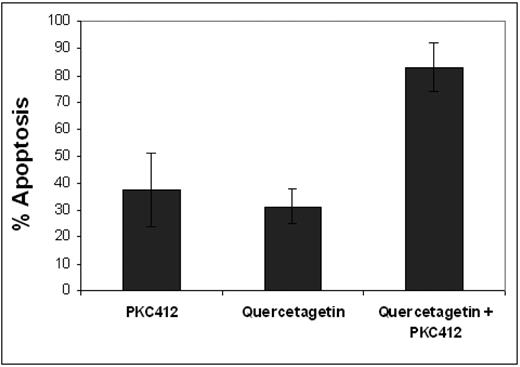Abstract
Fms-like tyrosine kinase 3 (FLT3) internal tandem duplication (ITD) results in FLT3 constitutive activation and aberrant signaling in acute myeloid leukemia (AML) cells. FLT3-ITD is associated with adverse treatment outcome in AML, but FLT3 inhibitors have had limited therapeutic efficacy. The oncogenic serine/threonine kinase Pim-1 is upregulated in AML cells with FLT3-ITD. Pim-1 inhibitors are entering clinical trials, and we sought to characterize the role of Pim-1 and the effects of Pim-1 inhibition in FLT3-ITD cells. Wild-type (WT) FLT3 exists predominantly in a 150 kDa complex glycosylated form. In contrast, FLT3-ITD is partially retained in the endoplasmic reticulum (ER) as a misfolded 130 kDa underglycosylated, or high-mannose, species in association with the ER transmembrane chaperone calnexin. In addition, FLT3-ITD also associates with and is stabilized by the cytosolic chaperone heat shock protein (HSP) 90. FLT3-ITD activates signal transducer and activation of transcription (STAT) 5 and upregulates the STAT5 downstream target Pim-1. FLT3 contains a putative Pim-1 substrate consensus serine phosphorylation site, and we hypothesized that FLT3 might be a Pim-1 substrate. FLT3-ITD cell lines studied included MV4-11, MOLM-14 and transfected Ba/F3-ITD, and FLT3 WT cells included BV173, EOL-1 and transfected Ba/F3-WT. Pim-1 activity was measured by an in vitro kinase assay of BAD phosphorylation at serine 112, and Pim-1 expression, FLT3 expression, phosphorylation and co-immunoprecipitation, and STAT5 phosphorylation and expression by Western blot analysis. Pim-1 knockdown was accomplished by infection with lentivirus containing Pim-1 small hairpin RNA (shRNA) or non-target control, and Pim-1 kinase inhibition by incubation with the Pim-1-selective inhibitor quercetagetin. Pim-1 was found to directly interact with and serine-phosphorylate FLT3 from FLT3-ITD, but not FLT3-WT, cells in vitro. Inhibition of Pim-1 kinase disrupted binding of FLT3 to its chaperones calnexin and HSP90, and resulted in decreased expression and half-life of 130 kDa FLT3 and increased expression and half-life of 150 kDa FLT3. The decrease in expression and half-life of 130 kDa FLT3 was partially abrogated by co-incubation with the proteasome inhibitor MG132. Moreover, the increase in 150 Kda FLT3 was abrogated by co-incubation with the glycosylation inhibitor 2-deoxy-D-glucose. Thus Pim-1 maintains FLT3 as a 130 kDa species by enhancing its binding to its chaperones calnexin and HSP90, protecting it from proteasomal degradation and inhibiting its glycosylation to form 150 kDa FLT3. Inhibition of Pim-1 kinase activity also decreased phosphorylation of FLT3 at tyrosine 591, a docking site for binding of FLT3-ITD, but not FLT3-WT, to STAT5, and decreased both STAT5 phosphorylation and expression of Pim-1 itself. In contrast, Pim-1 inhibition had no effect on FLT3 tyrosine kinase activity nor on expression of Pim-2, another Pim kinase family member implicated in promoting survival of FLT3-ITD cells. Finally, the Pim-1 kinase inhibitor quercetagetin and the FLT3 inhibitor PKC412 had a synergistic effect in inducing apoptosis of Ba/F3-ITD cells:
We conclude that Pim-1, which is transcriptionally upregulated through STAT5 in FLT3-ITD cells, serine-phosphorylates FLT3-ITD, thereby maintaining it in an underglycosylated form, and promotes STAT5 signaling, and that inhibition of Pim-1 and of FLT3 is synergistic in inducing apoptosis of FLT3-ITD cells. Thus Pim-1 inhibitors should inhibit aberrant signaling upstream as well as downstream of Pim-1 in FLT3-ITD cells, and have the potential to enhance the therapeutic efficacy of FLT3 inhibitors in patients with AML with FLT3-ITD
No relevant conflicts of interest to declare.

This icon denotes an abstract that is clinically relevant.
Author notes
Asterisk with author names denotes non-ASH members.


This feature is available to Subscribers Only
Sign In or Create an Account Close Modal